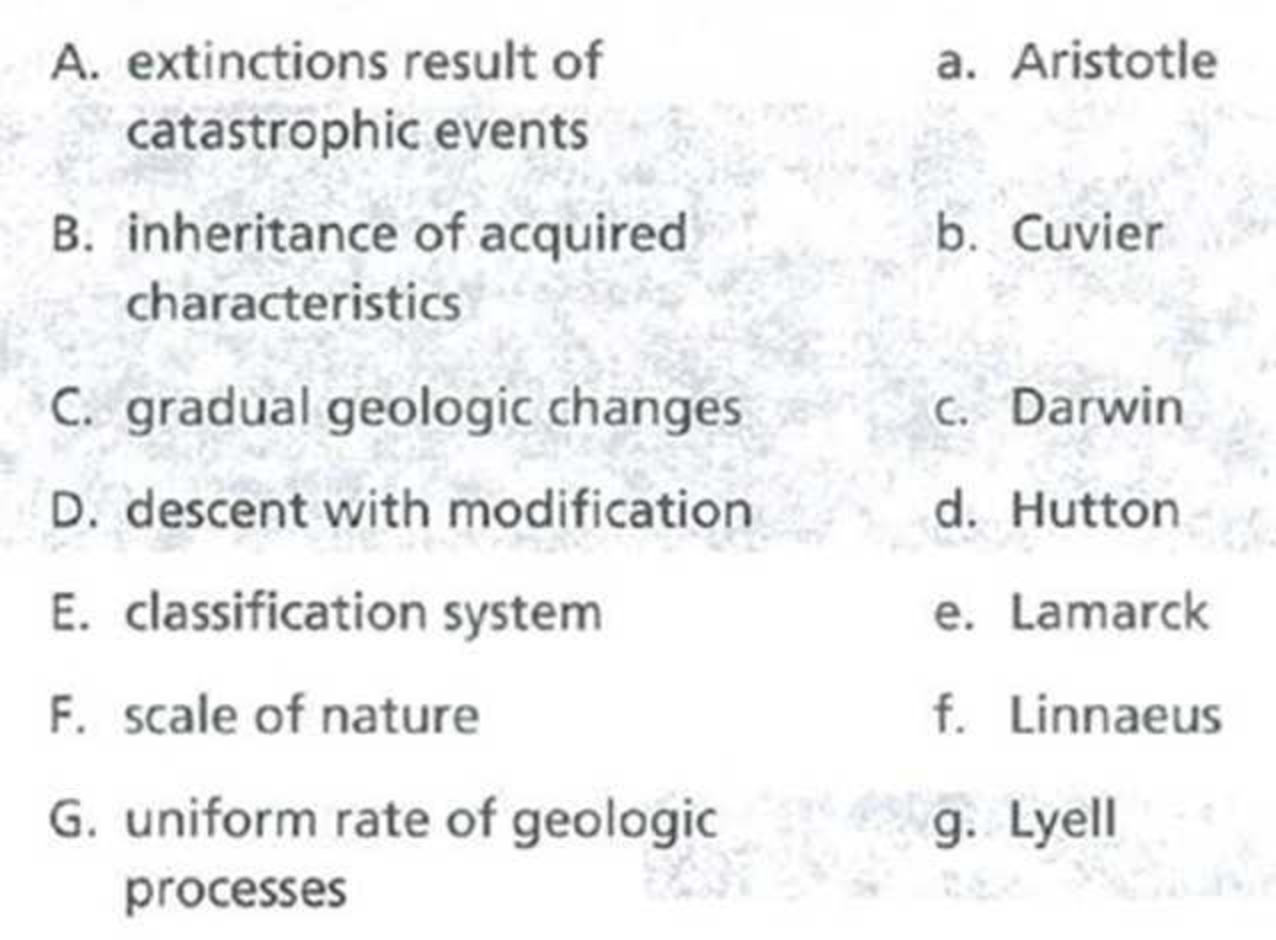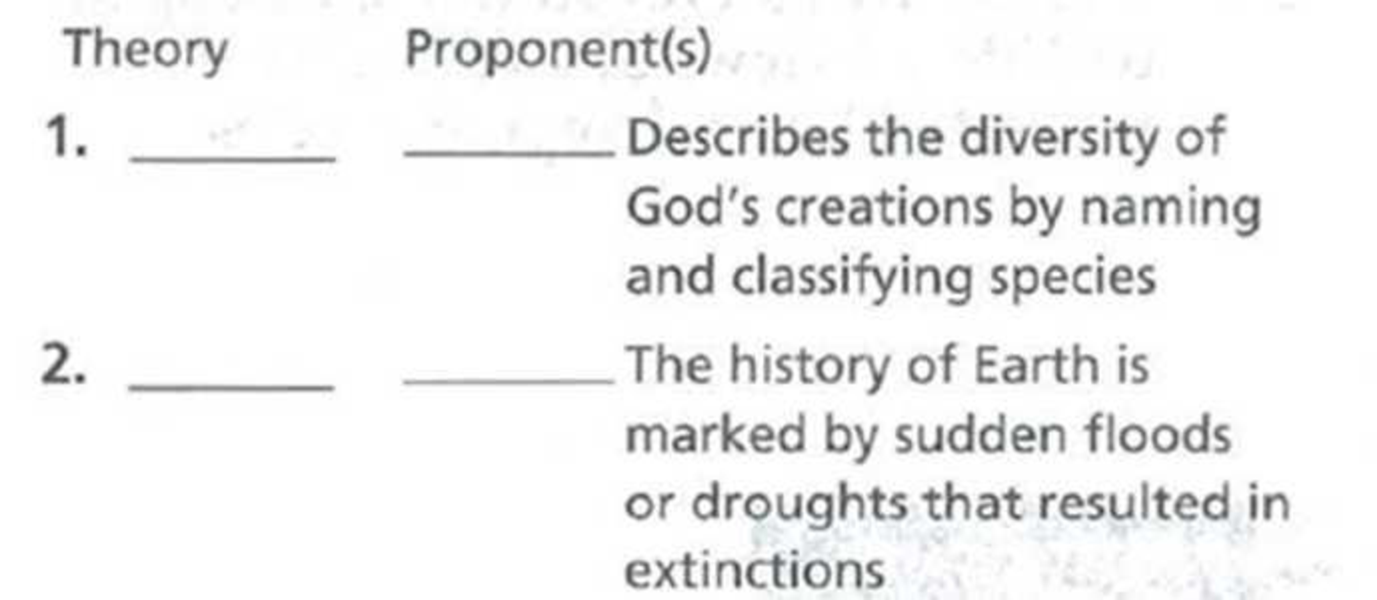
Concept explainers
- a. Write the capital letter representing the theory or philosophy and the lowercase letter(s) representing its proponent(s) in the blanks preceding the following seven descriptions.



- b. Now place the people listed in a through g in chronological order according to the dates of their ideas regarding change over time.
__________
a.
To match: The theory or philosophy with their respective proponents.
Introduction: Our earth was formed before 4.6 billion years from the sun with continuous bombardment of huge rocks and ice. When the Earth was formed, chemical evolution began, which formed organic molecules. Organic molecules led to evolution of protobionts.
Answer to Problem 1IQ
| S. No | Theory | Proponents |
| 1 | E. classification system | f. Linnaeus: Describes the diversity of God’s creations by naming and classifying species. |
| 2 | A. extinctions result of catastrophic events | b. Cuvier: The history of Earth is marked by sudden floods or droughts that resulted in extinctions. |
| 3 | B. inheritance of acquired characteristics | e. Lamarck: Proposed mechanism of evolution in which modification due to use or disuse are passed on to offspring. |
| 4 | C. gradual geologic changes | d. Hutton: Profound change is the product of slow but continuous processes |
| g. Lyell: Profound change is the product of slow but continuous processes | ||
| 5 | F. scales of nature |
a. Aristotle: Earth contains fixed species on a continuum from simple to complex |
| 6 | D. decent with modification | c. Darwin: All of life is related; present day species differ from ancestral species |
| 7 | G. uniform rate of geologic processes | g. Lyell: Geologic processes have constant rates throughout time |
Explanation of Solution
- 1. Classification system theory was proposed by Linnaeus. This theory describes the diversity of God’s creation by their different naming and classification of species.
- 2. Cuvier explained the philosophy that extinctions are the result of catastrophic events. He explained that extinctions and differences as the history of earth, those were marked by sudden catastrophic events. These are the indicatives of evolution.
- 3. Lamarck explained the mechanism of evolution by two principles. The two evolution principles are the use and disuse of body parts that leads to development or deterioration, and the inheritance of acquired characters.
- 4. Hutton and Lyell proposed the theory of gradual geologic changes. They explained the theory that profound changes occurs as per cumulative but continuous processes.
- 5. “Aristotle (384-322 BCE)” studied the closeness of different organisms and categorized them according to their nature of complexity. One of the significant observations by Aristotle was the shift of organisms from a simple state to a perfect state.
- 6. Darwin summarized his view of life in a phrase “descent with modification” in terms of unity and diversity. Sharing many characteristics by organisms made Darwin to observe unity in their lives. The unity in their lives was due to sharing common ancestors living in their remote past. Living in different habitats, these descendants gradually acclimatize to various modifications that enable them to adapt to specific environments.
- 7. Lyell proposed the theory of uniform rate of geologic processes. This theory explained that the geologic processes function at a constant rate and continue in the present.
b.
To place: The above listed people in a through g in chronological order as per the dates of their ideas regarding the change over time.
Introduction: Evolution is a process that has been taking place since the origin of life. Species have evolved themselves according to their needs with their changing surrounding environment. To explain these changes taking place in different species of plants and animals, different theories have been put forward from time to time.
Answer to Problem 1IQ
Correct answer: The correct chronological order for the people given is as follows:
Explanation of Solution
The chronological order as per the dates for the above listed people in a through g for their ideas regarding the change over time are as follows:
- Aristotle (384-322 BCE) proposed the theory of scales of nature.
- Then in the 1700s, Linnaeus developed the idea of binomial system of naming.
- Hutton proposed the theory of gradualism on 1795.
- Lamarck proposes the hypothesis of evolution on 1809.
- Cuvier on 1812 publishes his expensive studies of vertebrate fossils.
- Lyell proposes the theory of geological changes on 1830.
- Then the greatest phase of evolution, “descent with modification” invented by Darwin on 1844.
Want to see more full solutions like this?
Chapter 22 Solutions
Study Guide for Campbell Biology
Additional Science Textbook Solutions
Microbiology: Principles and Explorations
Principles of Anatomy and Physiology
Laboratory Manual for Holes Human Anatomy & Physiology Fetal Pig Version
Campbell Biology in Focus (2nd Edition)
Human Anatomy & Physiology
LooseLeaf for Integrated Principles of Zoology
- Based on your observation and knowledge, what is the most important problem faced by the human being ? A disease, daily life issues, social issues etc (anything is possible!).Please define your research question or problem. Propose your solution with engineering or scientific approach. Use your imagination and innovative approach.arrow_forwardBased on your observation and knowledge, what is the most important problem faced by the human being? A disease, daily life issues, social issues etc. (anything is possible!). Please define your research question or problem. Propose your solution with engineering or scientific approach. Use your imagination and innovative approach. Please dont available answer because it is wrong.arrow_forwardWhat is meant by science is a human endeavor influenced by society and culture.arrow_forward
- List some of the sub-fields found in physical anthropology, and state what each studies A. Genes and skeletons of primates, osteology, and forensics B. biology, geology, dating techniques, chemistry, and genetics C. flora analysis of graves along with faunal studies of domesticaetd animals D. cultural anthropology, physical anthropology, archaeology, primate studiesarrow_forwardCan an argument really be any text that expresses a point of view ?arrow_forwardWrite an essay about yourselfarrow_forward
- Give a clear explanation handwritten answer....and need explanation of each point...arrow_forwardPLEASE HELP ME TO CHOOSE THE LETTER OF THE CORRECT ANSWER.1. The purpose of taking into considerations the time when the conceptual paradigm be developed is due to which of the following reason? A.To prove its relationship to the variables being investigated B. To serve as a reference for determining the significance of the study C. To justify the chosen research topic D. To serve as reference in developing the hypothesis2. The difference between facts and theory is that theory is A. more complex B. Less broad C. more concrete D. less concrete3. In preparing your research proposal you know that the four major section are the following except: A. Introduction B. Summary C. Conclusion D. Discussion of Theoretical Literature4. After the problem has been carefully delineated and clearly stated, Nurse Carmencita is now ready to conduct a literature review. The review of related literature involves which of the following: A. All of the above B. Systematic identification of literature…arrow_forwardGive at least two realistic examples that compared and contrast Normal Science and Post-Normal Science in essay formarrow_forward
- Choose a theory or concept involving biomechanics and discuss how you can apply it when having a job as a physical therapist. a) which biomechanical theory is used? b) how will this concept specifically relate to a physical therapist's job. (Use specific examples: what you would do, instructors on how to set up drill, rehab or classroom activity.) c) why you feel this is important to a physical therapist?arrow_forwardWhat can older people learn from your generation in terms of technology? Answer in 3 paragraphs.arrow_forwardIn each of the following examples, choose the term that correctly describes the human body according to anatomical position.a. In the anatomical position, the palms are forward or backward.b. The liver is superior or inferior to the diaphragm.c. The hand is proximal or distal to the elbow.d. The shoulder blade is on the anterior or posterior part of the body.e. Cranial refers to the head or tail end of the body.f. The coronal plane divides the body into front and back or right and left sections. g. The arms are located on the medial or lateral side of the body. h. The transverse plane divides the body into superior and inferior or anterior and posterior parts.arrow_forward
 Comprehensive Medical Assisting: Administrative a...NursingISBN:9781305964792Author:Wilburta Q. Lindh, Carol D. Tamparo, Barbara M. Dahl, Julie Morris, Cindy CorreaPublisher:Cengage Learning
Comprehensive Medical Assisting: Administrative a...NursingISBN:9781305964792Author:Wilburta Q. Lindh, Carol D. Tamparo, Barbara M. Dahl, Julie Morris, Cindy CorreaPublisher:Cengage Learning Fundamentals of Sectional Anatomy: An Imaging App...BiologyISBN:9781133960867Author:Denise L. LazoPublisher:Cengage Learning
Fundamentals of Sectional Anatomy: An Imaging App...BiologyISBN:9781133960867Author:Denise L. LazoPublisher:Cengage Learning- Essentials Health Info Management Principles/Prac...Health & NutritionISBN:9780357191651Author:BowiePublisher:Cengage
 Medical Terminology for Health Professions, Spira...Health & NutritionISBN:9781305634350Author:Ann Ehrlich, Carol L. Schroeder, Laura Ehrlich, Katrina A. SchroederPublisher:Cengage Learning
Medical Terminology for Health Professions, Spira...Health & NutritionISBN:9781305634350Author:Ann Ehrlich, Carol L. Schroeder, Laura Ehrlich, Katrina A. SchroederPublisher:Cengage Learning





